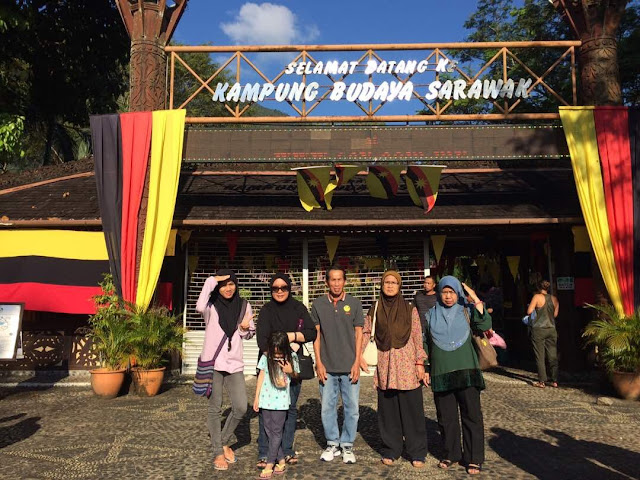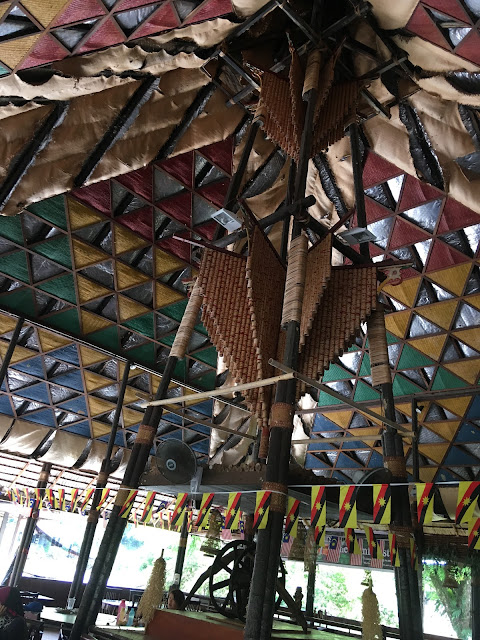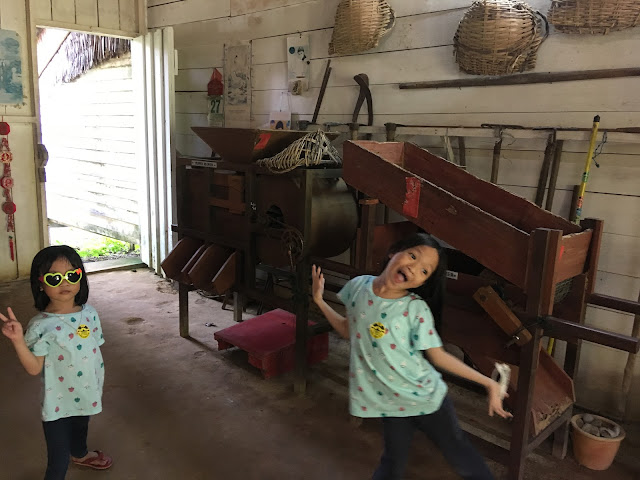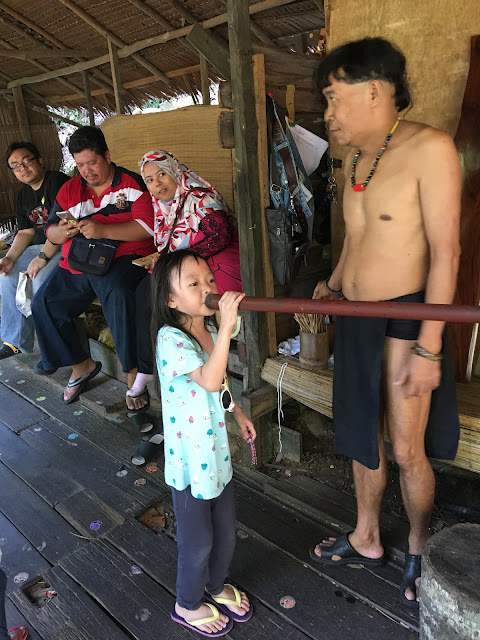We happened to be in Kuching, Sarawak for our Merdeka (Malaysia's Independence Day)/Aidiladha break. In conjunction with the Merdeka break, we decided to bring our kids to Sarawak Cultural Village (SCV) to get them acquainted to their own grassroot traditions of being Sarawakians.
 |
| In front of SCV entrance |
Entrance price for non-Sarawakians are RM60++ for adults (++ inclusive of 6% GST). Kids above the age of 7 are charged at 50% of adult's price. However, being local Sarawakians, we got the privilege of getting special prices (RM25++ for adults).
 |
| We were issued with these tickets that are valid for only one day. The downside is we didn't get the passport to stamp each time we completed a tour at the traditional houses |
We were issued tickets as well as wrist band that we had to wear at all times, yet allowed us to enter and leave the premise freely without being charged twice. The first building we saw on our right housed a restaurant that features local delicacies, a souvenir shop as well as the cultural theater. Our first stop was at the restaurant first to have our lunch.
 |
| The main building that housed the cultural performance theater, a souvenir shop and Sarawak Ethnic Kitchen that served authentic Sarawakian cuisine |
We opted for a meal set consisting of a combination of Sarawak various ethnic food - manok pansoh (chicken cooked in bamboo), umai (Melanau's version of sashimi seasoned with lime, chillies and onions), ikan asam pedas (fish cooked in sour and spicy style), daging tepus (meat), squashed tapioca leaves, wild ginger fern, fruits and complimentary drinks.
 |
| From top clock-wise: Umai, manok pansoh, ikan asam pedas and squashed tapioca leaves |
 |
| Interesting colourful motifs adorn the restaurant ceiling |
 |
| Sarawak Ethnic Kitchen has two dining area - air-conditioned and open air |
Although the food served was delicious, we couldn't help but notice that the service was quite slow (we were made to wait for half an hour to wait for our meal set to arrive, although it presumably it is best-selling item. On the other hand, perhaps they wanted to prepare the meals fresh). A couple of foreign tourists with young children had to go to the counter to check on their order as it took a long time as well. I felt that this is something they definitely need to improve to preserve a good image of the SCV.
After lunch, our first pit stop was at the Chinese Farmhouse. Chinese in Sarawak descended from the Hakka or Foochow clan, who came to Sarawak in the early 1900s as farmers. That is why we saw many farming tools on display inside the house. According to SCV's website, the house itself is divided into two main parts; the family room which contains the kitchen, eating and living area as well as a storage area for valuables such as bicycles or agricultural machinery, and the bedroom.
 |
| My kids posing in front of an agricultural machinery (I believed to process white pepper) |
 |
| Posing in front of the house exterior - the wall is made of whitewashed sawn timber while the roof is thatched with leaf attap |
Next house we stopped by was the Malay house. Unlike the Chinese Farmhouse, Malay house is built on stilts, and the staircase will lead visitors to a verandah before coming to the front door. The windows are cut to floor level to allow breeze for the seated people (I just found this out from SCV's website LOL). The first room that visitors will see is the living area. Rooms are separated by curtains to maintain the modesty of the females living in the house whenever visitors come by. At the back of the house is a spacious kitchen area.
 |
| Le Hubby is teaching Khadeeja to play a traditional Malay game called 'congkak' |
 |
| Malay house (Rumah Melayu) |
The most interesting (and challenging) house to visit in our opinion is the Melanau Tall House (Rumah Melanau). It is built very high above the ground (forty feet high) to protect the house dwellers from enemy attacks (traditionally, Melanau people lived near the sea within reach of pirates). We once were told that whenever enemies attacked, the people on the house will pull up the log staircase to prevent enemies from climbing up to the house and pour hot water on the enemies that tried to climb the poles. The most interesting architectural design of the house is the thatched roof, which is woven in such a way that if enemies threw fire on the roof, they can easily detached the particular patch of the roof and reveal a second layer of the roof (if I understood the story correctly).
 |
| Rumah Melanau from the front |
 |
| My kids attempting to climb the log staircase |
 |
| Inside the Melanau tall house |
 |
| The house is double storey and to reach the top floor, one has to climb up another log staircase |
Our next stop was the Orang Ulu Longhouse where we even get to enjoy a traditional musical performance by an Orang Ulu at their spacious verandah.
 |
| Orang Ulu Longhouse in the background |
 |
| Gongs, porcelain jars of all sizes were among valuable items on display in the longhouse |
 |
| Historical factsheet on display told us that body tattoos symbolized a lady's social standing - the more tattoos she can afford to get, the more affluent is her family |
Perhaps the simplest structure at the SCV is the Penan Hut. Penan people were (are) a nomadic tribe who lived deep in the heart of the Borneo jungle. Their shelters are quick to be constructed to last for several weeks to several months nearby area with abundant food supply, only to be abandoned once the supply has dwindled to search for new areas. They also hunted for wild animals using blowpipes which Le Hubby and Khayla had had a try at during this visit, for a nominal fee.
 |
| Khayla taking a rest in front of the Penan Hut |
 |
| Having a go at the blowpipe (although her lungs were not able to generate enough force to shoot at far targets!) |
Lastly, before we ended our tour at the Cultural Theater, we visited the Iban's and Bidayuh's (collectively known as the Dayaks) longhouses, where our girls had fun donning on traditional costumes and posing in front of cameras (even other tourists were taking their photos!)
 |
| Khayla donning on a Bidayuh ethnic costume complete with headgear |
 |
| Khadeeja opted for the Kayan ethnic costume with colorful beads on black cloth, complete with feathers accessories |
 |
| The girls posing with a SCV guide in Iban costume |
Our visit ended with a splendid dance performances of various Sarawak ethnics which never failed to mesmerize me. The girls also were as spellbound as they watched an Iban warrior lifted a heavy 'lesung' using his teeth, and a Melanau man propelled on a long pole by the sheer power of his core muscle!
 |
| The opening dance was enough to capture my girls' attention |
 |
| A Melanau performance |
Overall it was both an educational and entertaining visit, which is suitable for families and first-time tourists alike. I think the tour would be more interesting if the management could organize a guided tour with knowledgable tour guides who can tell the origins, facts and trivias (such as the wonderful engineering design of the Melanau Tall House roof) to tourists such as done in cultural places in Europe. I would not mind paying premium for a guided tour in exchange for a rich information on Sarawak's history. In fact they can also play historical movies (e.g. Warkah Terakhir on the story of Rosly Dhoby, or even that movie potraying Jessica Alba as an Iban lass!). There are a lot of potentials that the management can explore to provide a better experience to visitors.
If you are in Kuching and haven't visited Sarawak Cultural Village, I highly recommend this place for a crash course of Sarawak culture.
Rating: 7/10

























0 Comments:
Post a Comment
Thank you for coming by.
Comments are your responsibility.
Any comments are subjected to the Act 588 MCMC 1988.
Comment wisely, and do it with pure intentions.
Happy Blogging .